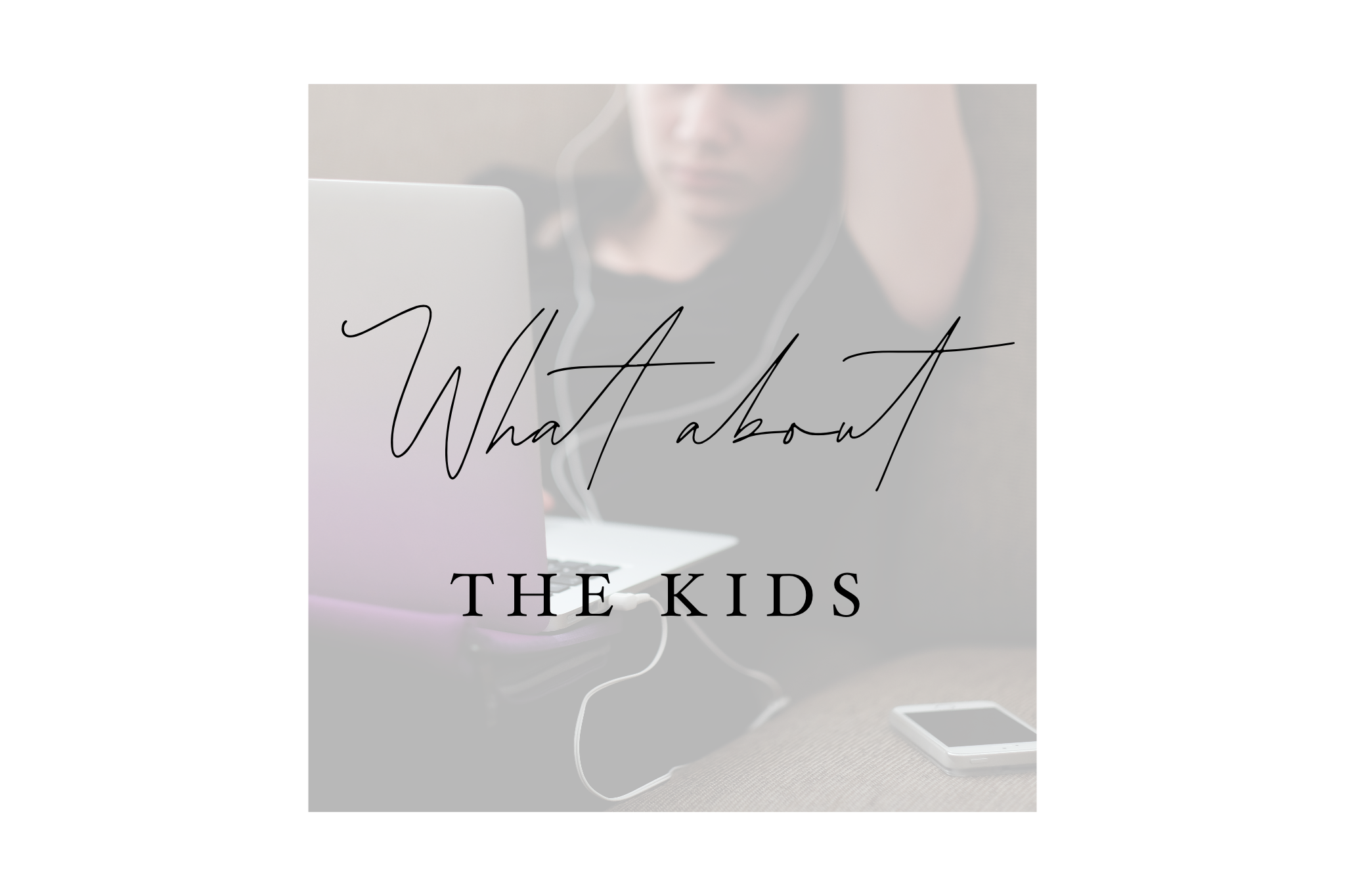“Kids need Bigger, Strong, Wise & Kind Adults.”
-methodist children's home Trust-Based Relational Intervention Training
In honor of back-to-school, let’s shine a light on our kids in this digital culture. We have spent the past eight months talking about our own digital well-being. As adults and parents, we know it starts with us. It must.
But now I’m venturing into the world of our kids. This is tender territory for me, remembering needs in my own young self, as a child growing up: To be seen. To be heard. To be safe. I also have kids, so I feel my own shortcomings blaring in my face and see the deep needs of these young lives in my home. As I said, this is a tender space.
I want to say upfront how brilliant and brave kids and teens are today. As an educator, mentor, and mom, I have worked closely with, taught, and raised these digital natives and am in awe of them. It’s easy for us to focus on where they are lacking or the negative influences affecting their generation as a whole, but it’s important for us to look for the gold in them and call it forth. They deeply desire that kind of care.
They need us and we need them.
Also, it would be irresponsible of us to only look at these coming generations without looking at the former ones, ourselves, and those before us. Yes, kids today are more anxious than any generation before them. So are we. “Anxiety disorders are the most common mental illness in the U.S., affecting 40 million adults in the United States" - aada.org Yes, kids today are dealing with the highest levels of self-harm and suicide. So are we. Yes, kids today are more insecure than ever. So are we. Yes, kids today are walking through individual and collective trauma.
SO ARE WE.
We cannot address anyone else until we see ourselves more clearly. In psychology, this is known as mirroring. Mirroring is matching someone's behavior, and it’s also known as limbic synchrony. It is the act of mimicking those around us. For many of us adults, we are anxious and distracted people today.
Let’s look at distraction and mirror neurons.
“At birth, a baby’s brain has a hundred billion neurons, most of which are not connected. The neurons begin to form connections with one another when the child engages with their parents and others around them—for instance, when a baby smiles and their parent smiles back, or a baby cries and a parent responds with a hug. These types of reciprocal exchanges are known as “serve and return” interactions because they work like a game in which a ball is volleyed back and forth. The child sends a signal, and the parent responds. Serve and return helps connect neurons in the brain to support language and communication skills, and as a child grow, these interactions help them learn emotional control, as well as important non-verbal emotional cues (for instance, what anger and happiness look like). The more responsive we are to their elemental attempts at communication. The more they learn the world is a pretty safe place.” Jeanne Williams, child psychologist
Researchers at Boston University School of Medicine observed that when parents were distracted by a device at dinner, they had 20 percent less conversation with their kid and 39 percent fewer non-verbal interactions. The tech interruptions start early on in our relationships with our kids, disrupting even little things like eye contact. And the consequences are real. University of Cambridge researchers have found that when mom and baby lock eyes, their brainwave patterns sync up so that scans of their brain activity look very similar. Researchers concluded that gaze powerfully signals to the baby that mom is available and interested in communicating, and the baby in turn will make more vocalizations and greater attempts to interact. - Todaysparent.com
Much of our lives as parents are lived behind screens, and it influences these mirror neurons of the ones in our homes. So, are kids always on their phones, and is it affecting them? Absolutely. And, it is a learned behavior, magnified X1000 with the digitally addictive design of their technology.
What happened in our kids this last year and a half, behind closed doors with blue lights glowing on faces? What internal questions were asked? What questions were answered by videos they took in and by people they chatted with? What narratives were formed in their developing minds? Our kids are taking their questions to places that are listening - “showing them attention” and grabbing theirs. Siri is not the only one answering questions. The deep-down questions of need are being answered throughout many of the places our kids are online. Am I important? Is the world a good or bad place? Am I safe? Am I pretty? Do my friends like me? Am I strong? Am I loved? Do I belong?
What I’m learning about openness in parent-child/teen relationships is dropping defenses leaves an open door. #talkmore
Humility. Listening. Attuning. Being Present.
I’ve spent a lot of time with parents talking about this issue. From “my kid will never get a phone” all the way to “my toddler loves to play all day on my phone” and everything in between. What I will say is most of us are making these decisions about our kids’ screens and digital boundaries from a place of our own issues. I know this because I’m living it. I know this because I study it. I know this because I’m walking it with you with my kids and with the collective world. Our own unresolved issues influence our decisions with our kids, and not just digitally. We respond from places of fear or control rather than being proactive from a place of desiring freedom, goodness, and independence for our kids.
Many times the fear/control response seems to make sense, particularly when we see the devastation online that is trying to engulf our kids. But, even if we are impacted by TikTok’s Devious Lick trend, we have to #talkmore and address it. Educate. Advocate. Have conversations about legal consequences, and boundaries, and engage kids/teens with clarity. Get involved in policies, like the ones we promote here monthly. This is where change happens. There will be new illegal viral trends. The reality is technology has become one of the most influential parts of our lives, and especially our kids. Taking it away will not solve it. Resignation and letting the digital world shape our kids will not solve it either.
Delayed age exposure, education & advocacy can.
Many of us have been reading and experiencing the effect that social media and our devices, in general, are having on this generation of kids and teens. Thank goodness for all of the important research that is coming out about it. I have also linked some resources below, including the new and damning evidence WSJ uncovered from Facebook’s own internal mental health research, The Facebook Files. (Don't miss that link & more below)
I want to end with ways we can engage these issues with reason and wisdom, rather than fear and control:
What are kids universally, most likely, dealing with, and what can we do about it?
Healthy digital habits to set them on a trajectory of mental stability to digitally flourish at this time.
Helpful resources and ways we can get them support. (click on the links below)
Excessively Available. This is the biggest one I hear. Kids/teens need to be there for a friend at all times. They feel they have to be available at all times for anyone to get ahold of them. It is not uncommon for them to be on suicide watch for friends who are self-harming.
How we can help. Have clear and reasonable hours to be on devices and when to be off, especially overnight. Talk about how to point our friends to professionals/counselors and caregivers to be their support. Our kids are not meant to take that on themselves. As heartbreaking as it is, they are not equipped to be their friends’ “therapist.” Yes, they can be a listening ear and support, but not literally holding their friends’ lives in their hands. I have had this very conversation with my teenagers so that they understand the importance of not trying to take on roles that they aren’t trained for or doing the same to their friends.
When they are doing important tasks, use the “Focus” feature on the phone and block distracting notifications, or just put the phone away during the tasks. Help them limit notifications, especially big group texts. These can cause anxiety when constantly blowing up their phone.
Excessively ON. Much of life is recorded and public. This is an immense amount of pressure as well as responsibility. There’s the social pressure of not messing up in the digital age. There’s the personal pressure to maintain an online presence by checking posts to see likes and comments and navigate bullying (though they don’t call it that). There’s the anxious pressure to not miss anything due to being left out or out of the know.
How we can help. In our Digital Wellness Presentations, we talk about our digital footprint. This is so important for this generation to realize that everything they do on their phone and on their devices is forever. No disappearing snap is truly gone. The decisions they make on their devices are important, but also, they will mess up. Everyone does, so we need to be there with them at that time.
Excessively Attached. There’s a lot that goes into this regarding attachment styles and who is more attached to their devices and who is not. But, pretty universally, kids/teens are growing up attached to their phones. Much of this is due to the ever-evolving and growing tech industry. There are important petitions, regulations, and requirements putting pressure on these companies and the inhumane design of their products on a policy level, but for now, these devices are designed to addict.
How we can help. Awareness of this issue is helpful. Educate your family on this issue and make good tech habits a thing in your home. Every small step is important. No phone in the room at bedtime. Put away phones at mealtimes. Set App limits and downtime in screentime settings. They won’t thank you externally, but they need intervention, and for most kids, it will not happen on their own. You will see big changes from these small steps.
Excessively Targeted. This is not a made-up paranoid theory of kids and devices. They are targeted. Monetarily targeted by the tech industry and advertisers. Sexually targeted by Traffickers, pedophiles, and the porn industry. Their characters are targeted by cyberbullying and “online friends.”
How we can help. Especially for young kids, setting up privacy settings, location settings, age limits, screen time settings, and most importantly, TALK MORE. For older kids, guiding them to set up their own screen time settings and giving space to LISTEN MORE. Don’t be shocked or they will shut down. I have made this mistake. Play it cool. Keep it open. Create a safe place for them to open up about what they experience and encounter on their devices. Be involved in their lives online and off. They want to be seen and heard, even if externally they are pushing you away. Don't buy it.
LOOK UP. SHOW UP. BE PRESENT.
-Dawn Wible, Founder
Find resources for healthy digital habits at talkmoretechless.com
sources: child mind institute, center for humane technology, digital wellness institute, pew research center, fairplayforkids.org, apa.org, bark.us

